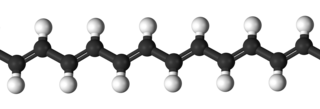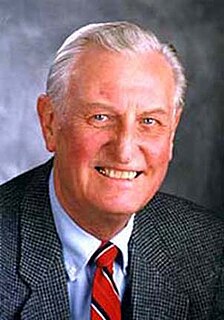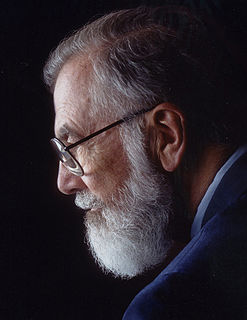Related Research Articles

Hideki Shirakawa is a Japanese chemist, engineer, and Professor Emeritus at the University of Tsukuba and Zhejiang University. He is best known for his discovery of conductive polymers. He was co-recipient of the 2000 Nobel Prize in Chemistry jointly with Alan MacDiarmid and Alan Heeger.

Plastic recycling is the reprocessing of plastic waste into new and useful products. When performed correctly, this can reduce dependence on landfill, conserve resources and protect the environment from plastic pollution and greenhouse gas emissions. Although recycling rates are increasing, they lag behind those of other recoverable materials, such as aluminium, glass and paper. The global recycling rate in 2015 was 19.5%, while 25.5% was incinerated and the remaining 55% disposed of to landfill. Since the beginning of plastic production in the 20th century, until 2015, the world has produced some 6.3 billion tonnes of plastic waste, only 9% of which has been recycled, and only ~1% has been recycled more than once.

Polymer science or macromolecular science is a subfield of materials science concerned with polymers, primarily synthetic polymers such as plastics and elastomers. The field of polymer science includes researchers in multiple disciplines including chemistry, physics, and engineering.

Robert Howard GrubbsForMemRS was an American chemist and the Victor and Elizabeth Atkins Professor of Chemistry at the California Institute of Technology in Pasadena, California. He was a co-recipient of the 2005 Nobel Prize in Chemistry for his work on olefin metathesis.
Jean M.J. Fréchet is a French-American chemist and Professor Emeritus at the University of California, Berkeley. He is the head of the Division of Materials Synthesis and Materials Science of the Lawrence Berkeley National Laboratory, Director of the Organic and Macromolecular Facility for the Molecular Foundry at the Lawrence Berkeley National Laboratory, and Vice-President for research at King Abdullah University of Science and Technology. He has authored nearly 900 scientific papers and holds over 70 United States patents. His research areas include organic synthesis and polymer chemistry applied to nanoscience and nanotechnology with emphasis on the design, fundamental understanding, synthesis, and applications of functional macromolecules.
Craig Jon Hawker is an Australian-born chemist. His research has focused on the interface between organic and polymer chemistry with emphasis on the design, synthesis, and application of well-defined macromolecular structures in biotechnology, microelectronics and surface science.
Carl Shipp "Speed" Marvel was an American chemist who specialized in polymer chemistry. He made important contributions to U.S. synthetic rubber program during World War II, and later worked at developing polybenzimidazoles, temperature-resistant polymers that are used in the aerospace industry, in fire-fighting equipment, and as a replacement for asbestos. He has been described as "one of the world's outstanding organic chemists" and received numerous awards, including the 1956 Priestley Medal and the 1986 National Medal of Science, presented by President Ronald Reagan.

Krzysztof "Kris" Matyjaszewski is a Polish-American chemist. He is the J.C. Warner Professor of the Natural Sciences at the Carnegie Mellon University Matyjaszewski is best known for the discovery of atom transfer radical polymerization (ATRP), a novel method of polymer synthesis that has revolutionized the way macromolecules are made.

Takuzo Aida is a polymer chemist known for his work in the fields of supramolecular chemistry, materials chemistry and polymer chemistry. Aida, who is the Deputy Director for the RIKEN Center for Emergent Matter Science (CEMS) and a professor in the Department of Chemistry and Biotechnology, School of Engineering, at the University of Tokyo, has made pioneering contributions to the initiation, fundamental progress, and conceptual expansion of supramolecular polymerization. Aida has also been a leader and advocate for addressing critical environmental issues caused by plastic waste and microplastics in the oceans, soil, and food supply, through the development of dynamic, responsive, healable, reorganizable, and adaptive supramolecular polymers and related soft materials.

Otto Vogl was an American chemist, polymer scientist, and educator.

Polymer Journal is the official journal of the Society of Polymer Science, Japan (SPSJ) and publishes original articles, notes, short communications and reviews on developments in macromolecule research. It is an international peer-reviewed journal that is published on a monthly basis. The current Editor-in-Chief is Keiji Tanaka of Kyushu University, Japan.

Harvey Douglas Keith was a physicist and one of the primary polymer researchers over the latter half of the 20th century.
The Journal of Photochemistry and Photobiology is a series of peer-reviewed scientific journals covering the fields of photochemistry and photobiology, published by Elsevier. It was originally established in 1972, and split into Journal of Photochemistry and Photobiology A: Chemistry and Journal of Photochemistry and Photobiology B: Biology in 1987. A third title; Journal of Photochemistry and Photobiology C: Photochemistry Reviews, was established in 2000 and is the official journal of the Japanese Photochemistry Association.
Polymer Chemistry is a peer-reviewed scientific journal published by the Royal Society of Chemistry covering all aspects of the chemistry of synthetic and biological macromolecules and related emerging areas. It was established in February 2010 as a monthly journal and switched to biweekly in 2013. The editor-in-chief is Christopher Barner-Kowollik, while the executive editor is Neil Hammond. According to the Journal Citation Reports, the journal has a 2018 impact factor of 4.760.
ACS Macro Letters is a peer-reviewed scientific journal published by the American Chemical Society. As of 2017, ACS Macro Letters has the highest impact factor of any journal in the field of polymer science (6.131). With the launch of ACS Macro Letters, all Communications to the Editor that were formerly published in Macromolecules will be published as Letters in ACS Macro Letters. Researchers are advised turn to ACS Macro Letters for reports of early, urgent results in polymer science and to Macromolecules for more detailed discussions of comprehensive research findings.
Kaushal Kishore (1942–1999) was an Indian polymer chemist and head of the department of inorganic and physical Chemistry at the Indian Institute of Science (IISc). He was known for his researches on thermochemistry and combustion of polymers. and was an elected fellow of the National Academy of Sciences, India, Indian National Science Academy, and the Indian Academy of Sciences. The Council of Scientific and Industrial Research, the apex agency of the Government of India for scientific research, awarded him the Shanti Swarup Bhatnagar Prize for Science and Technology, one of the highest Indian science awards, in 1988, for his contributions to chemical sciences.
Mitsuo Sawamoto is a Japanese chemist specializing in the field of polymer chemistry, Emeritus Professor at Kyoto University, professor at Chubu University.
Christopher W. Macosko (1944) is an American chemical engineer and professor emeritus in the Department of Chemical Engineering and Materials Science at the University of Minnesota. He is internationally known for his work in polymer science and engineering, especially in the areas of rheology and polymer processing. Macosko is an author of more than 500 academic papers, dozens of patents, and two books including the text: "Rheology: Principles, Measurements and Applications". He served as Director of the Industrial Partnership for Research in Interfacial and Materials Engineering (IPRIME), a university-industry consortium at the University of Minnesota, from 1999 to 2018. Macosko and his wife Kathleen have been married since 1967 and are long-time residents of Minneapolis. They have four children and 12 grandchildren.
Virgil Percec is a Romanian-American chemist and P. Roy Vagelos Chair and Professor of Chemistry at the University of Pennsylvania. Expert in organic, macromolecular and supramolecular chemistry including self-assembly, biological membrane mimics, complex chiral systems, and catalysis. Pioneered the fields of liquid crystals with complex architecture, supramolecular dendrimers, Janus dendrimers and glycodendrimers, organic Frank-Kasper phases and quasicrystals, supramolecular polymers, helical chirality, Ni-catalyzed cross-coupling and multiple living and self-interrupted polymerizations. Most of these concepts were inspired by Nature and biological principles.
References
- ↑ "What is SPSJ ?". SPSJ. Retrieved 2010-05-06.